Integration of Digital Technologies in Corporate Social Responsibility (CSR) Activities: A Systematic Literature Review and Bibliometric Analysis
Abstract
1. Introduction
- Ethical and Responsible Handling of Data—digital technologies allow companies to collect, process, and analyze large volumes of personal data from consumers. In the context of CSR, companies must demonstrate ethical conduct and responsible behavior in collecting and managing these data. This includes respecting personal privacy, providing clear information about the purposes of data processing, and ensuring the protection of personal data from misuse and breaches (Quach et al. 2022);
- Transparency and Accountability in Technology Utilization—digital technologies have the potential to facilitate the establishment of transparent and accountable business practices. Companies that aspire to be socially responsible must ensure clear and understandable information regarding how they employ their technologies and the impact they have on society and the environment. Publicly disclosing information about corporate digital practices is a crucial element in the endeavor to enhance trust in the company (Bekele 2023);
- Opportunities for Innovation and Social Challenges—digital technologies offer unique opportunities for companies to innovate and create new products and services that can address social challenges, contributing to sustainability and improving quality of life (Dionisio et al. 2023);
- Reducing Digital Divide—digital technologies present countless opportunities for innovation and growth. Companies committed to CSR play a crucial role in reducing the digital divide by striving to ensure access and equal opportunities for digital technologies across all layers of society (Basu 2017);
- Cybersecurity and Customer Protection—cybersecurity becomes an increasingly vital aspect of corporate responsibility in the context of the increasing digitization of business and society. Companies must invest in cybersecurity and protect their customers’ data to prevent abuses and breaches of personal information (Serabian 2015).
- RQ1: What are the most influential publications, authors, and institutions that deal with the research on digital technologies in CSR activities?
- RQ2: How has the literature in the field of integrating digital technologies in CSR developed historically and how has it spread geographically?
- RQ3: What is the scope of research, and what are the key trends for future scientific research in the field of integrating digital technologies in CSR activities?
- RQ4: Is there an integration of digital technology into the CSR activities?
2. Materials and Methods
3. Results
3.1. Data Collection
- Defining key words, terms, and the field of search in the database. Defining key words and terms for searching the Scopus database is the result of a panel discussion among the research authors and specialists in the field of information technologies and the implementation of CSR in business. Searching and extracting during the data collection phase involve the use of different search techniques, such as Booleans, use of quotation marks and parenthesis, and truncations. The selected key words run in two directions: regarding the applicable digital technologies (“digit*” OR “digital technolog*”), and, regarding the field of CSR (“CSR” OR “corporate social responsib*”). Appropriate Boolean operators OR and AND have been used. The query in the database based on these key words was conducted on 9 June 2023 in a specific field (Article title, Abstract, Key word) and the generated result was 899 documents.
- Selection of additional search criteria. The selected PRISMA protocol requires defining additional search criteria that limit the sample. Those criteria are selected by the authors who have used the search filters suggested in the Scopus database. The selected criteria options limit the sample to the following:
- Open Access—All open access;
- Year—we have selected a period of published articles between 2014 and 2023;
- Subject area—we have selected the areas Business, Management and Accounting, Social Sciences; Environmental Science; Computer Science; and Economics, Econometrics, and Finance;
- Document Type—we are only interested in articles/Article;
- Publication Stage—only completed articles with the option Final are selected;
- Source Type—we have selected articles published in journals Journal; and
- Language—the research encompasses articles in English only with the option English.
- Cleaning the data. A very important part of the process of data processing is its cleaning. It is related to eliminating some of the records. The PRISMA protocol requires that the research materials (in this case 129 scientific publications) be checked for duplicates to eliminate them. The check has shown that there are no duplicates. Another reason for cleaning the data is the review and assessment of the articles to determine their relevance and eligibility. The titles and abstracts of the selected documents in the sample have been reviewed by the authors. After an in-depth discussion, all articles in the sample have been accepted as relevant to the scientific research.
- Data storage. The extracted data have been exported to a .csv file and stored for the purposes of their analysis. In addition, we have stored the full text copies of the articles in the sample. The query has been stored in the Scopus database.
3.2. Performing Descriptive and Performance Analysis
3.3. Performing Science Mapping with VOSviewer
3.3.1. Citation Analysis
- Citation analysis by documents. The citation analysis when the analysis criterion documents is selected presents the articles based on their being cited in other documents across the whole Scopus database. At this stage, VOSviewer allows only those articles for which a minimum number of citations of a document is selected by the user to be selected. The authors have selected 3 as the number of citations. This criterion is met by 72 documents in the sample, which is approximately 56% of the total number of 129 articles. At the next stage, the software brings forward the list of documents identified with the names of authors and the year of their publication, which contains two types of information: (1) the number of citations of those 72 documents in Scopus; and (2) the number of mutual citations of those 72 documents in the remaining documents in the sample, which form links among them.
- The science map shows the most influential publications and authors (the largest circles), but also that the sample indicates an extremely low level of citation links of the articles. Those that have cited each other are colored because they form clusters. The largest clusters are in red (three items) and in green (three items).
- In a search of the most influential publications and authors, we have performed a ranking of the articles in a sample based on the total number of citations in Scopus and the formed clusters compared to the number of articles in the sample linked by citing. We have performed normalization based on the number of citations, which is an option in VOSviewer. The results of this in-depth analysis are shown in Table 5, whereas the science map is shown in Figure 4. The science map shows that two clusters are positioned in it; this is illustrated in Figure 5 and Figure 6.
- Citation analysis by authors. The citation analysis by authors reveals information about the author with the most articles and the most citations. The objects of the analysis are the articles and citations of all 443 authors of the 129 researched articles. The authors have been selected on the basis of a minimum number of articles and minimum number of citations (in Scopus). In this particular case, for both criteria we have selected a value of 1. This restriction returns a list of 289 authors, who, against the total number of 443, are 65.2%. In the list, the authors are ranked on the basis of the number of authored articles, the total number of citations of those articles in Scopus and the number of citations of one article in one journal in an article in another journal out of the totality of articles by 289 authors. Based on the last criterion, the values are between 8 and 0, which means that the authors of articles in the sample are cited between 8 and 0 times by other authors in the same sample. Some of the authors have a substantial number of citations in the Scopus database (for instance, Ahmad, N.); however, they have been cited by none of the authors in this sample. The science map shows several clusters, which show in reality several multi-authored publications. The science map is visualized with VOSviewer and is shown in Figure 7.
- Citation analysis by sources. The citation analysis can also generate data about the most influential scientific journals in which articles are published. The object of the analysis is those 87 sources in which all 129 documents have been published. The ranking of the journals is performed simultaneously based on the number of articles in the sample in a specific journal, the total number of citations of those articles in all remaining documents across the whole Scopus database, and the number of citations of one article in one journal by another journal out of the totality of 87 items. At this stage, VOSviewer allows only those articles for which the minimum number of documents of a source and minimum number of citations of a source are selected by the user to be selected. In this research, the authors have selected, for both options, a value of 2. The restrictions are met by nine sources out of 87, i.e., 10.3% of the total sources. At the next stage, the software brings forward a list of the journals, which contains information in three directions: (1) number of articles in each of the nine journals; (2) number of citations in Scopus of those articles that have been published in the selected journals; and (3) the mutual citations of articles within those nine journals in the sample, which form among each other, relationships of specific strength.
- The science map shows the most influential publications (the largest circles). It is important to note that there are only two journals in the sample that have a relationship between them, but the visualization does not allow this relationship to be revealed. These are the journals Sustainability (Switzerland) and Frontiers in Environmental Science, which have mutually cited one article per journal. There is no level of connectivity via citations among the remaining journals in the sample.
- To reveal the most influential journals in which the articles in the sample are published, we have performed a ranking of the nine journals based on the number of published articles in each of them, the total number of citations of the articles in Scopus, and the clusters with the number linked by citing articles in the sample. The results of this in-depth analysis are shown in Table 6, whereas the science map is shown in Figure 8.
3.3.2. Co-Authorship Analysis
3.3.3. Bibliographic Coupling
3.3.4. Co-Citation Analysis
3.3.5. Co-Occurrence Analysis
4. Discussion
5. Conclusions
- Digitalization of accounting and communication;
- Application of digital technologies in various aspects of the modern business;
- Innovations regarding digital solutions in the field of CSR (it is more frequently that companies use artificial intelligence, blockchain, the Internet of Things (IoT), virtual reality, and other technologies to improve the efficiency and impact of CSR activities);
- Knowledge sharing, collaboration, good practices (via online platforms, mobile applications, and networks among the stakeholders);
- Enhancing the quality of managerial decisions through more efficient monitoring, data analysis, and assessments of the efficiency and impact of CSR activities;
- Ethical and legal aspects of integrating digital technologies in CSR (problems of personal data protection, cybersecurity, and the responsible use of artificial intelligence);
- Strategies and the management of digital technologies in CSR (development of strategies and managerial models for integrating digital technologies in CSR);
- Social aspects of the process of integrating digital technologies in CSR (research on the social effects—the impact of competences, workplaces, education, access to technologies, digital inequality, and vulnerable groups).
- Social media and online communications (for popularizing CSR and communication with the stakeholders);
- Internet platforms for donations and volunteering (for engaging more employees and outsiders and management of the collected donations);
- Data analysis (for an assessment of the impact of CSR activities—data collection and analysis regarding the environmental footprint, social indicators, and ethical practices);
- Interactive educational technologies and resources (for encouraging education and the engagement of employees and other stakeholders—courses, video conferences, online events, and learning materials);
- Technologies for accounting and analysis (blockchain, digital tracking systems, and accounting, which guarantees transparency and lowers the risk of misuse).
Author Contributions
Funding
Data Availability Statement
Conflicts of Interest
References
- Abdullah, and Mohammed Naved Khan. 2021. Determining Mobile Payment Adoption: A Systematic Literature Search and Bibliometric Analysis. Edited by Elena Kostadinova. Cogent Business & Management 8: 1893245. [Google Scholar] [CrossRef]
- Abina, Andreja, Tanja Batkovič, Bojan Cestnik, Adem Kikaj, Rebeka Kovačič Lukman, Maja Kurbus, and Aleksander Zidanšek. 2022. Decision Support Concept for Improvement of Sustainability-Related Competences. Sustainability 14: 8539. [Google Scholar] [CrossRef]
- Ahmad, Naveed, Miklas Scholz, Zia Ullah, Muhammad Zulqarnain Arshad, Raja Irfan Sabir, and Waris Ali Khan. 2021a. The nexus of csr and co-creation: A roadmap towards consumer loyalty. Sustainability 13: 523. [Google Scholar] [CrossRef]
- Ahmad, Naveed, Rana TahirNaveed, Miklas Scholz, Muhammad Irfan, Muhammad Usman, and Ilyas Ahmad. 2021b. CSR Communication through Social Media: A Litmus Test for Banking Consumers’ Loyalty. Sustainability 13: 2319. [Google Scholar] [CrossRef]
- Aitken, Mhairi, Magdalene Ng, Dave Horsfall, Kovila P. L. Coopamootoo, Aad van Moorsel, and Karen Elliott. 2021. In pursuit of socially-minded data-intensive innovation in banking: A focus group study of public expectations of digital innovation in banking. Technology in Society 66: 101666. [Google Scholar] [CrossRef]
- Ajiferuke, Isola, Quentin Burell, and Jean Tague. 1988. Collaborative Coefficient: A Single Measure of the Degree of Collaboration in Research. Scientometrics 14: 421–33. [Google Scholar] [CrossRef]
- Alieva, Jamila, and Daryl John Powell. 2023. The significance of employee behaviours and soft management practices to avoid digital waste during a digital transformation. International Journal of Lean Six Sigma 14: 1–32. [Google Scholar] [CrossRef]
- Basu, Subhajit. 2017. Beyond Agenda: Digital Divide and Corporate Social Responsibility. ResearchGate. [Google Scholar] [CrossRef]
- Bekele, Sophia. 2023. The Role of Transparency and Accountability in Digital Transformation. ISACA. Available online: https://www.isaca.org/resources/news-and-trends/industry-news/2023/the-role-of-transparency-and-accountability-in-digital-transformation (accessed on 20 July 2023).
- Börner, Katy, Chaomei Chen, and Kevin W. Boyack. 2005. Visualizing Knowledge Domains. Annual Review of Information Science and Technology 37: 179–255. [Google Scholar] [CrossRef]
- Brown, Timothy. 2015. Confirmatory Factor Analysis for Applied Research. New York: The Guilford Press. 462p. [Google Scholar]
- Camilleri, Mark Anthony. 2019. The SMEs’ technology acceptance of digital media for stakeholder engagement. Journal of Small Business and Enterprise Development 26: 504–21. [Google Scholar] [CrossRef]
- Cardinali, Pier Giacomo, and Pietro De Giovanni. 2022. Responsible digitalization through digital technologies and green practices. Corporate Social Responsibility and Environmental Management 29: 984–95. [Google Scholar] [CrossRef]
- Carroll, Archie B. 1991. The pyramid of corporate social responsibility: Toward the moral management of organizational stakeholders. Business Horizons 34: 39–48. [Google Scholar] [CrossRef]
- Carroll, Archie B. 1999. Corporate Social Responsibility: Evolution of a Definitional Construct. Business & Society 38: 268–95. [Google Scholar] [CrossRef]
- Charumathi, Balakrishnan, and Padmaja Gaddam. 2018. The Impact of Regulations and Technology on Corporate Social Responsibility Disclosures – Evidence from Maharatna Central Public Sector Enterprises in India. Australasian Accounting, Business and Finance Journal 12: 5–28. [Google Scholar] [CrossRef]
- Cheng, Guping, Jacob Cherian, Muhammad Safdar Sial, Grzegorz Mentel, Peng Wan, Susana Álvarez-Otero, and Usama Saleem. 2021. The Relationship between CSR Communication on Social Media, Purchase Intention, and E-WOM in the Banking Sector of an Emerging Economy. Journal of Theoretical and Applied Electronic Commerce Research 16: 1025–41. [Google Scholar] [CrossRef]
- Ciarli, Tommaso, Martin Kenney, Silvia Massini, and Lucia Piscitello. 2021. Digital technologies, innovation, and skills: Emerging trajectories and challenges. Research Policy 50: 104289. [Google Scholar] [CrossRef]
- Cobo, Manuel Jesús, Antonio Gabriel López-Herrera, Enrique Herrera-Viedma, and Francisco Herrera. 2011. Science Mapping Software Tools: Review, Analysis, and Cooperative Study among Tools. Journal of the American Society for Information Science and Technology 62: 1382–402. [Google Scholar] [CrossRef]
- Costa, Joana, and João Matias. 2020. Open innovation 4.0 as an enhancer of sustainable innovation ecosystems. Sustainability 12: 8112. [Google Scholar] [CrossRef]
- Danylevych, Natalia, and Oksana Poplavska. 2020. Social responsibility and social partnership in the 4th industrial revolution context: Case of Ukraine. REVESCO Revista de Estudios Cooperativos 135: 1–18. [Google Scholar] [CrossRef]
- Dionisio, Marcelo, Sylvio Jorge de Souza Junior, Fábio Paula, and Paulo César Pellanda. 2023. The role of digital social innovations to address SDGs: A systematic review. Environment, Development and Sustainability 34: 100442. [Google Scholar] [CrossRef]
- Donthu, Naveen, Satish Kumar, Debmalya Mukherjee, Nitesh Pandey, and Weng Marc Lim. 2021. How to Conduct a Bibliometric Analysis: An Overview and Guidelines. Journal of Business Research 133: 285–96. [Google Scholar] [CrossRef]
- Dreyer, Marc, Luc Chefneux, Anne Goldberg, Joachim von Heimburg, Norberto Patrignani, Monica Schofield, and Chris Shilling. 2017. Responsible Innovation: A Complementary View from Industry with Proposals for Bridging Different Perspectives. Sustainability 9: 1719. [Google Scholar] [CrossRef]
- Dudek, Marek, Iryna Bashynska, Svitlana Filyppova, Svitlana Yermak, and Dariusz Cichon. 2023. Methodology for assessment of inclusive social responsibility of the energy industry enterprises. Journal of Cleaner Production 394: 136317. [Google Scholar] [CrossRef]
- Elango, Bakthavachalam, and Periyaswamy Rajendran. 2012. Authorship Trends and Collaboration Pattern in the Marine Sciences Literature: A Scientometric Study. International Journal of Information Dissemination and Technology 2: 166–69. Available online: https://www.semanticscholar.org/paper/Authorship-Trends-and-Collaboration-Pattern-in-the-Elango-Rajendran/deb3cfa9b5f435b949b029791a0279290da2c623 (accessed on 28 May 2023).
- Etter, Michael, Christian Fieseler, and Glen Whelan. 2019. Sharing Economy, Sharing Responsibility? Corporate Social Responsibility in the Digital Age. Journal of Business Ethics 159: 935–42. [Google Scholar] [CrossRef]
- European Commission. 2020. Directorate General for Communications Networks, Content and Technology. In Shaping Europe’s Digital Future; Luxembourg: Publications Office of the European Union. [Google Scholar] [CrossRef]
- Fornell, Claes, and David Larcker. 1981. Evaluating Structural Equation Models with Unobservable Variables and Measurement Error. Journal of Marketing Research 18: 39–50. [Google Scholar] [CrossRef]
- Forrest, Charlotte, Stephen Monsell, and Ian McLaren. 2014. Is performance in task-cuing experiments mediated by task set selection or associative compound retrieval? Journal of Experimental Psychology: Learning Memory and Cognition 40: 1002–24. [Google Scholar] [CrossRef]
- Fritz, Heider. 1958. The Psychology of Interpersonal Relations. New York: John Wiley and Sons, Inc. 322p. [Google Scholar]
- Gao, Yuying, and Shanyue Jin. 2022. Corporate Nature, Financial Technology, and Corporate Innovation in China. Sustainability 14: 7162. [Google Scholar] [CrossRef]
- Gupta, Shuchi, Nishad Nawaz, Adel Abdulmhsen Alfalah, Rana Tahir Naveed, Saqib Muneer, and Naveed Ahmad. 2021. The Relationship of CSR Communication on Social Media with Consumer Purchase Intention and Brand Admiration. Journal of Theoretical and Applied Electronic Commerce Research 16: 1217–30. [Google Scholar] [CrossRef]
- Hopkins, Michael. 2004. Corporate social responsibility: An issues paper. In Policy Integration Department World Commission on the Social Dimension of Globalization. Working Paper No. 27. Geneva: International Labour Office. Available online: http://oit.org/wcmsp5/groups/public/---dgreports/---integration/documents/publication/wcms_079130.pdf (accessed on 2 June 2023).
- Hu, Qianqian, Tianlun Zhu, Chien-Liang Lin, Tiejun Chen, and Tachia Chin. 2021. Corporate social responsibility and firm performance in china’s manufacturing: A global perspective of business models. Sustainability 13: 2388. [Google Scholar] [CrossRef]
- Hur, Won-Moo, Hanna Kim, and Hyun Kyung Kim. 2018. Does customer engagement in corporate social responsibility initiatives lead to customer citizenship behaviour? The mediating roles of customer-company identification and affective commitment. Corporate Social Responsibility and Environmental Management 25: 1258–69. [Google Scholar] [CrossRef]
- Iglesias, Oriol, Stefan Markovic, Mehdi Bagherzadeh, and Jatinder Jit Singh. 2020. Co-creation: A Key Link Between Corporate Social Responsibility, Customer Trust, and Customer Loyalty. Journal of Business Ethics 163: 151–66. [Google Scholar] [CrossRef]
- Ionaşcu, Ion, Mihaela Ionaşcu, Elena Nechita, Marian Săcărin, and Mihaela Minu. 2022. Digital Transformation, Financial Performance and Sustainability: Evidence for European Union Listed Companies. Amfiteatru Economic 24: 94–109. [Google Scholar] [CrossRef]
- Jayaram, Dureen, Ajay K. Manrai, and Lalita A. A. Manrai. 2015. Effective use of marketing technology in Eastern Europe: Web analytics, social media, customer analytics, digital campaigns and mobile applications. Journal of Economics, Finance and Administrative Science 20: 118–32. [Google Scholar] [CrossRef]
- Jernigan, David, and Craig S. Ross. 2020. The Alcohol Marketing Landscape: Alcohol Industry Size, Structure, Strategies, and Public Health Responses. Journal of Studies on Alcohol and Drugs 19: 13–25. [Google Scholar] [CrossRef] [PubMed]
- Khattak, Amira, and Zahid Yousaf. 2022. Digital Social Responsibility towards Corporate Social Responsibility and Strategic Performance of Hi-Tech SMEs: Customer Engagement as a Mediator. Sustainability 14: 131. [Google Scholar] [CrossRef]
- Klein, Jill, and Niraj Dawar. 2004. Corporate social responsibility and consumers’ attributions and brand evaluations in a product-harm crisis. International Journal of Research in Marketing 21: 203–17. [Google Scholar] [CrossRef]
- Krysovatyy, Andriy, Iryna Zvarych, Oksana Brodovska, and Roman Zvarych. 2022. Global Social Sustainability and Inclusion: The ‘Voice’ of Social and Environmental Imbalances. Journal of Risk and Financial Management 15: 599. [Google Scholar] [CrossRef]
- Lamptey, Ebenezer K., Jin Dong Park, and Isaac Bonaparte. 2023. Does Corporate Social Responsibility Affect the Timeliness of Audited Financial Information? Evidence from ‘100 Best Corporate Citizens. Journal of Risk and Financial Management 16: 60. [Google Scholar] [CrossRef]
- Latif, Khawaja Fawad, Andrea Pérez, and Umar Farooq Sahibzada. 2020. Corporate social responsibility (CSR) and customer loyalty in the hotel industry: A cross-country study. International Journal of Hospitality Management 89: 102565. [Google Scholar] [CrossRef]
- Li, Huanli, Yun Wu, Dongmei Cao, and Yichuan Wang. 2021. Organizational mindfulness towards digital transformation as a prerequisite of information processing capability to achieve market agility. Journal of Business Research 122: 700–12. [Google Scholar] [CrossRef]
- Liu, Huifang, and Jin-Sup Jung. 2021. The Effect of CSR Attributes on CSR Authenticity: Focusing on Mediating Effects of Digital Transformation. Sustainability 13: 7206. [Google Scholar] [CrossRef]
- López, Belén. 2022. How Higher Education Promotes the Integration of Sustainable Development Goals—An Experience in the Postgraduate Curricula. Sustainability 14: 2271. [Google Scholar] [CrossRef]
- Ma, Rui, Jacob Cherian, Wen-Hsien Tsai, Muhammad Safdar Sial, Li Hou, and Susana Álvarez-Otero. 2021. The relationship of corporate social responsibility on digital platforms, electronic word-of-mouth, and consumer-company identification: An application of social identity theory. Sustainability 13: 4700. [Google Scholar] [CrossRef]
- Magrini, Chiara, Jana Nicolas, Holger Berg, Alberto Bellini, Enrico Paolini, Nazarena Vincenti, Luca Campadello, and Alessandra Bonoli. 2021. Using internet of things and distributed ledger technology for digital circular economy enablement: The case of electronic equipment. Sustainability 13: 4982. [Google Scholar] [CrossRef]
- Malynovska, Yuliia, Iryna Bashynska, Dariusz Cichon, Yuriy Malynovskyy, and Dariusz Sala. 2022. Enhancing the Activity of Employees of the Communication Department of an Energy Sector Company. Energies 15: 4701. [Google Scholar] [CrossRef]
- Merhabi, Mohamad Amir, Panagiotis Petridis, and Rushana Khusainova. 2021. Gamification for brand value co-creation: A systematic literature review. Information 12: 345. [Google Scholar] [CrossRef]
- Mikalef, Patrick, and Adamantia Pateli. 2017. Information technology-enabled dynamic capabilities and their indirect effect on competitive performance: Findings from PLS-SEM and fsQCA. Journal of Business Research 70: 1–16. [Google Scholar] [CrossRef]
- Mohammed, Maged, Khaled Riad, and Nashi Alqahtani. 2022. Design of a Smart IoT-Based Control System for Remotely Managing Cold Storage Facilities. Sensors 22: 4680. [Google Scholar] [CrossRef] [PubMed]
- Monteiro, Albertina Paula, Beatriz Aibar-Guzmán, María Garrido-Ruso, and Cristina Aibar-Guzmán. 2021. Employee-Related Disclosure: A Bibliometric Review. Sustainability 13: 5342. [Google Scholar] [CrossRef]
- Morris, Steven A., and Betsy Van Der Veer Martens. 2009. Mapping Research Specialties. Annual Review of Information Science and Technology 42: 213–95. [Google Scholar] [CrossRef]
- Muchiri, Martin Kamau, Szilvia Erdei-Gally, Mária Fekete-Farkas, and Zoltán Lakner. 2022. Bibliometric Analysis of Green Finance and Climate Change in Post-Paris Agreement Era. Journal of Risk and Financial Management 15: 561. [Google Scholar] [CrossRef]
- Mueller, Benjamin. 2022. Corporate Digital Responsibility. Business and Information Systems Engineering 64: 689–700. [Google Scholar] [CrossRef]
- Mulaessa, Naveedullah, and Hong Wang. 2017. The Effect of Corporate Social Responsibility (CSR) Activities on Consumers Purchase Intention in China: Mediating Role of Consumer Support for Responsible Business. International Journal of Marketing Studies 9: 73–81. [Google Scholar] [CrossRef][Green Version]
- Na, Chaohong, Xue Chen, Xiaojun Li, Yuting Li, and Xiaolan Wang. 2022. Digital Transformation of Value Chains and CSR Performance. Sustainability 14: 10245. [Google Scholar] [CrossRef]
- Nikulin, Christopher, Jaime Rubin de Celis, Gaetano Cascini, Raúl Stegmaier, and Marcel Minutolo. 2011. Anticipation of technological change through patent analysis and logistic growth curve. Paper presented at the Institute of Behavioral and Applied Management’s 2011 Annual Conference IBAM 19, Orlando, FL, USA, October 13–15; Edited by Paul H. Jacques. Bellevue: Bellevue University, pp. 1–15. [Google Scholar]
- Noyons, Everard Christiaan Marie, Henk Floribert Moed, and Marc Luwel. 1999. Combining Mapping and Citation Analysis for Evaluative Bibliometric Purposes: A Bibliometric Study. Journal of the American Society for Information Science 50: 115–31. [Google Scholar] [CrossRef]
- Okazaki, Shintaro, Kirk Plangger, Douglas West, and Héctor David Menéndez. 2020. Exploring digital corporate social responsibility communications on Twitter. Journal of Business Research 117: 675–82. [Google Scholar] [CrossRef]
- Orbik, Zbigniew, and Viera Zozul’aková. 2019. Corporate Social and Digital Responsibility. Management Systems in Production Engineering 27: 79–83. [Google Scholar] [CrossRef]
- Page, Matthew James, Joanne E. McKenzie, Patrick M. Bossuyt, Isabelle Boutron, Tammy C. Hoffmann, Cynthia D. Mulrow, Larissa Shamseer, Jennifer M. Tetzlaff, Elie A. Akl, Sue E. Brennan, and et al. 2021. The PRISMA 2020 Statement: An Updated Guideline for Reporting Systematic Reviews. BMJ 88: 105906. [Google Scholar] [CrossRef]
- Paliwoda-Matiolanska, Adriana, Emilia Smolak-Lozano, and Atsuho Nakayama. 2020. Corporate image or social engagement: Twitter discourse on corporate social responsibility (CSR) in public relations strategies in the energy sector. Profesional de la Informacion 29: e290333. [Google Scholar] [CrossRef]
- Pangalos, George. 2023. Financing for a Sustainable Dry Bulk Shipping Industry: What Are the Potential Routes for Financial Innovation in Sustainability and Alternative Energy in the Dry Bulk Shipping Industry? Journal of Risk and Financial Management 16: 101. [Google Scholar] [CrossRef]
- Paris, Bas, Dimitris Michas, Athanasios T. Balafoutis, Leonardo Nibbi, Jan Skvaril, Hailong Li, Duarte Pimentel, Carlota da Silva, Elena Athanasopoulou, Dimitrios Petropoulos, and et al. 2023. A Review of the Current Practices of Bioeconomy Education and Training in the EU. Sustainability 15: 954. [Google Scholar] [CrossRef]
- Patuelli, Alessia, Jonida Carungu, and Nicola Lattanzi. 2022. Drivers and nuances of sustainable development goals: Transcending corporate social responsibility in family firms. Journal of Cleaner Production 373: 133723. [Google Scholar] [CrossRef]
- Petrovich, Eugenio. 2021. Science Mapping and Science Maps. Knowledge Organization 48: 535–62. [Google Scholar] [CrossRef]
- Quach, Sara, Park Thaichon, Kelly D. Martin, Scott Weaven, and Robert W. Palmatier. 2022. Digital technologies: Tensions in privacy and data. Journal of the Academy of Marketing Science 50: 1299–323. [Google Scholar] [CrossRef] [PubMed]
- Ramesh, Kumar, Raiswa Saha, Susoban Goswami, and Richa Dahiya. 2019. Consumer’s response to CSR activities: Mediating role of brand image and brand attitude. Corporate Social Responsibility and Environmental Management 26: 377–87. [Google Scholar] [CrossRef]
- Rangel-Pérez, Celia, Manuel Fernández, and Belén López. 2023. Study on the strategic influence of corporate social responsibility in the world’s most digitised banks. Journal of Open Innovation: Technology, Market, and Complexity 9: 1–9. [Google Scholar] [CrossRef]
- Reguly, István Zoltán, and Michael Giles. 2015. Finite Element Algorithms and Data Structures on Graphical Processing Units. International Journal of Parallel Programming 43: 203–39. [Google Scholar] [CrossRef]
- Richert, Maria, and Marek Dudek. 2023. Risk Mapping: Ranking and Analysis of Selected, Key Risk in Supply Chains. Journal of Risk and Financial Management 16: 71. [Google Scholar] [CrossRef]
- Scherer, Andreas Georg, Andreas Rasche, Guido Palazzo, and André Spicer. 2016. Managing for Political Corporate Social Responsibility: New Challenges and Directions for PCSR 2.0. Journal of Management Studies 53: 273–98. [Google Scholar] [CrossRef]
- Serabian, David. 2015. Consumer Protection and Cybersecurity: The Consumer Education Gap. pp. 1–16. Available online: https://digitalscholarship.unlv.edu/brookings_pubs/33 (accessed on 20 July 2023).
- Shahadat, M. M. Hussain, Abu Hena Mohammed Yeaseen Chowdhury, Robert Jeyakumar Nathan, and Maria Fekete-Farkas. 2023. Digital Technologies for Firms’ Competitive Advantage and Improved Supply Chain Performance. Journal of Risk and Financial Management 16: 94. [Google Scholar] [CrossRef]
- Sheel, Ashutosh, and Vishnu Nath. 2019. Effect of Blockchain Technology Adoption on Supply Chain Adaptability, Agility, Alignment and Performance. Management Research Review 42: 1353–74. [Google Scholar] [CrossRef]
- Siano, Alfonso, Francesca Conte, Sara Amabile, Agostino Vollero, and Paolo Piciocchi. 2016. Communicating Sustainability: An Operational Model for Evaluating Corporate Websites. Sustainability 8: 950. [Google Scholar] [CrossRef]
- Singh, Nitya, and Paul Hong. 2023. CSR, Risk Management Practices, and Performance Outcomes: An Empirical Investigation of Firms in Different Industries. Journal of Risk and Financial Management 16: 69. [Google Scholar] [CrossRef]
- Stawicka, Ewa. 2021. Sustainable Development in the Digital Age of Entrepreneurship. Sustainability 13: 4429. [Google Scholar] [CrossRef]
- Suebsaiaun, Atisin, and Thepparat Pimolsathean. 2018. Thai home improvement retailer customer loyalty: A SEM analysis. Journal of International Studies 11: 120–37. [Google Scholar] [CrossRef]
- Tariq, Emad, Muhammad Alshurideh, Iman Akour, Sulieman Al-Hawary, and Barween Al Kurdi. 2022. The role of digital marketing, CSR policy and green marketing in brand development. International Journal of Data and Network Science 6: 995–1004. [Google Scholar] [CrossRef]
- Topor, Dan Ioan, Silvia Ștefania Maican, Carmen Adina Paștiu, Irina Bogdana Pugna, and Mircea Ștefan Solovăstru. 2022. Using CSR Communication through Social Media for Developing Long-Term Customer Relationships. The Case of Romanian Consumers. Economic Computation and Economic Cybernetics Studies and Research 56: 255–72. [Google Scholar] [CrossRef]
- Tranfield, David, David Denyer, and Palminder Smart. 2003. Towards a Methodology for Developing Evidence-Informed Management Knowledge by Means of Systematic Review. British Journal of Management 14: 207–22. [Google Scholar] [CrossRef]
- van den Broek, Tijs, David Langley, and Tobias Hornig. 2017. The Effect of Online Protests and Firm Responses on Shareholder and Consumer Evaluation. Journal of Business Ethics 146: 279–94. [Google Scholar] [CrossRef]
- Van Eck, Nees Jan, and Ludo Waltman. 2010. Software Survey: VOSviewer, a Computer Program for Bibliometric Mapping. Scientometrics 84: 523–38. [Google Scholar] [CrossRef] [PubMed]
- Vasile, Valentina, Mirela Panait, and Simona-Andreea Apostu. 2021. Financial inclusion paradigm shift in the postpandemic period. Digital-divide and gender gap. International Journal of Environmental Research and Public Health 18: 10938. [Google Scholar] [CrossRef] [PubMed]
- Vogler, Daniel, and Mark Eisenegger. 2021. CSR Communication, Corporate Reputation, and the Role of the News Media as an Agenda-Setter in the Digital Age. Business and Society 60: 1957–86. [Google Scholar] [CrossRef]
- Vollero, Agostino, Maria Palazzo, Alfonso Siano, and Pantea Foroudi. 2021. From CSR to CSI: Analysing consumers’ hostile responses to branding initiatives in social media-scape. Qualitative Market Research 24: 143–60. [Google Scholar] [CrossRef]
- Warren, Scott, Brian Sauser, and David Nowicki. 2019. A Bibliographic and Visual Exploration of the Historic Impact of Soft Systems Methodology on Academic Research and Theory. Systems 7: 10. [Google Scholar] [CrossRef]
- Xin, Daleng, Yanzhen Yi, and Jianjun Du. 2022. Does digital finance promote corporate social responsibility of pollution-intensive industry? Evidence from Chinese listed companies. Environmental Science and Pollution Research 29: 85143–59. [Google Scholar] [CrossRef]
- Yu, Yuetian, Yujie Li, Zhongheng Zhang, Zhichun Gu, Han Zhong, Qiongfang Zha, Luyu Yang, Cheng Zhu, and Erzhen Chen. 2020. A Bibliometric Analysis Using VOSviewer of Publications on COVID-19. Annals of Translational Medicine 8: 816. [Google Scholar] [CrossRef] [PubMed]
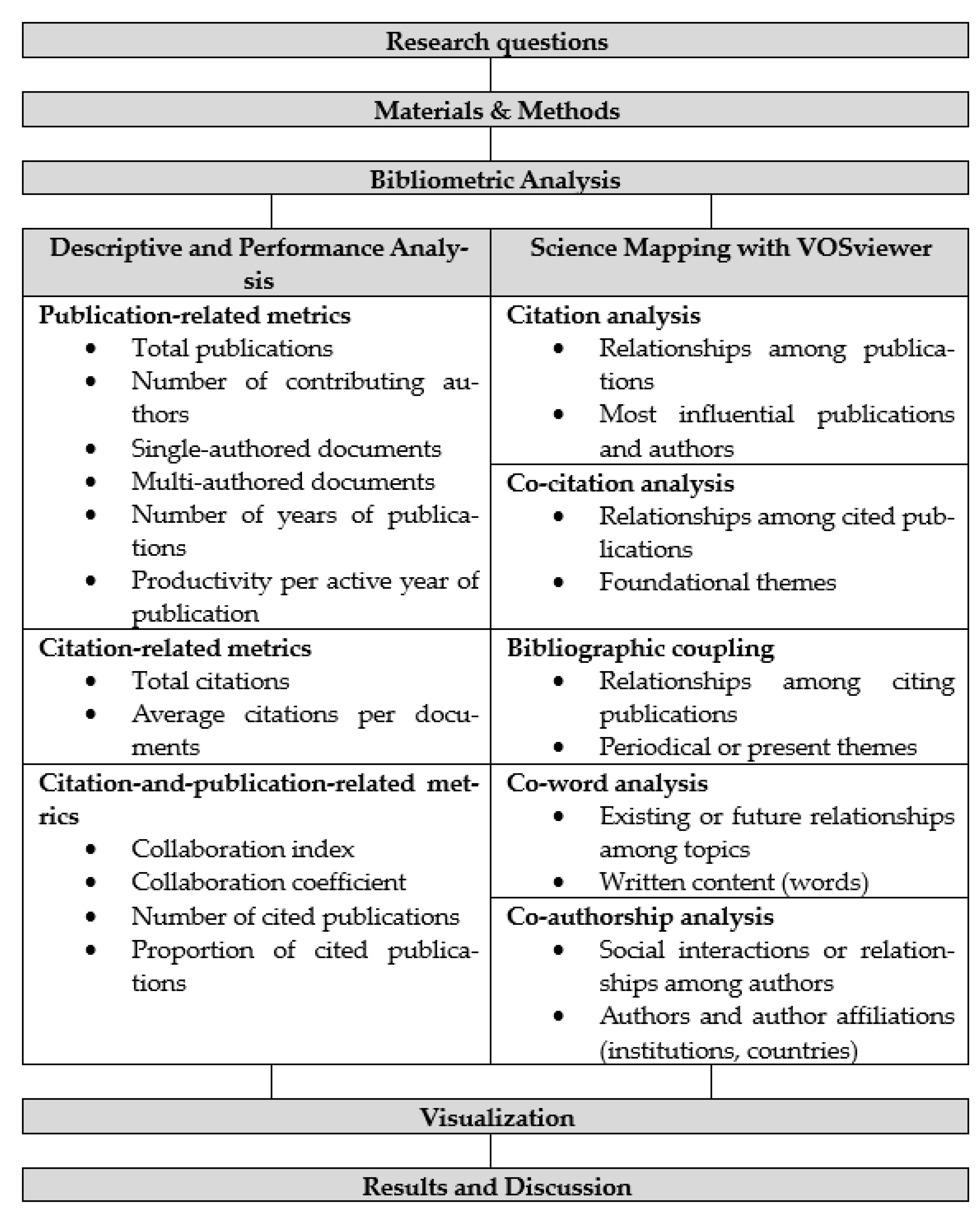
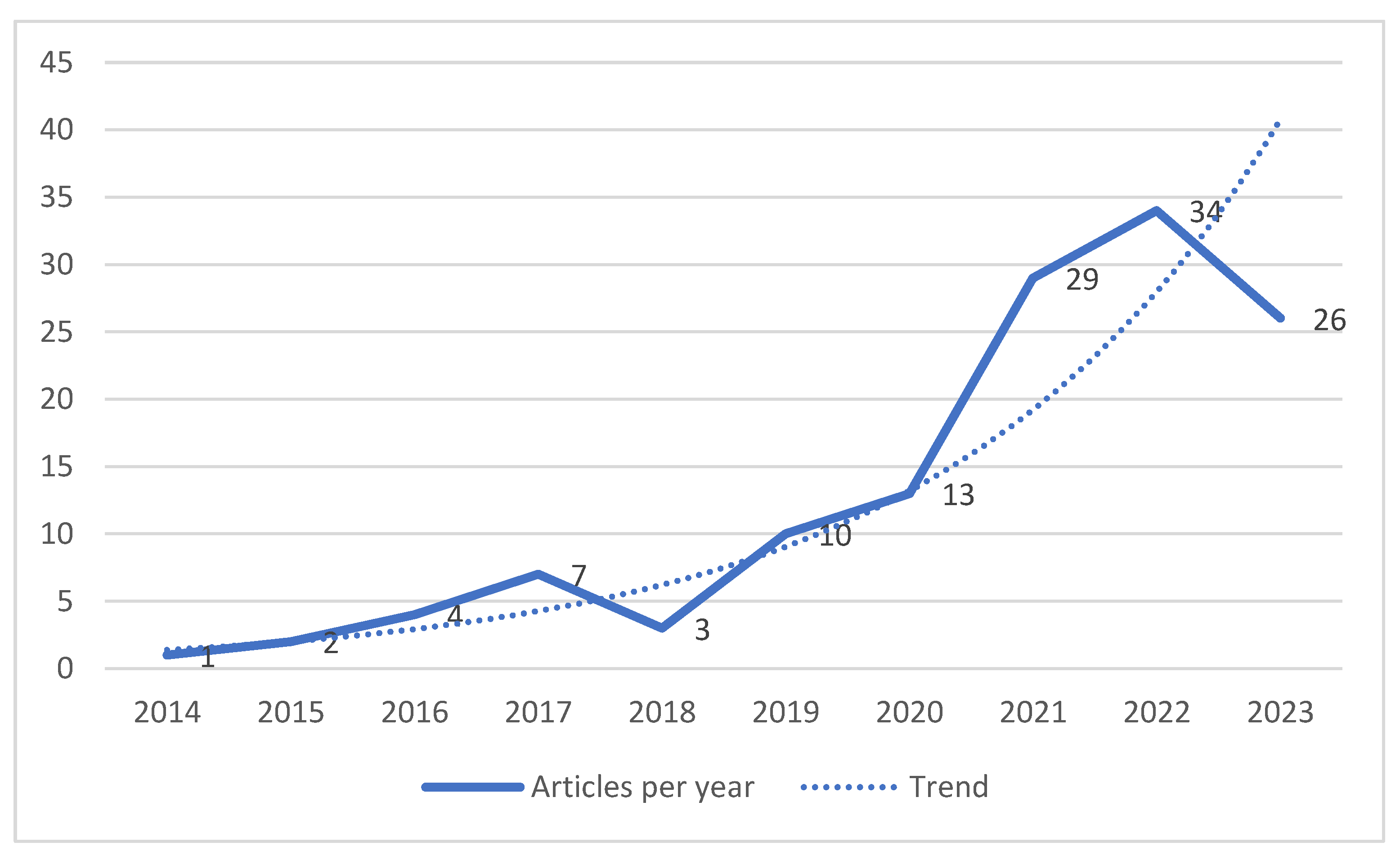
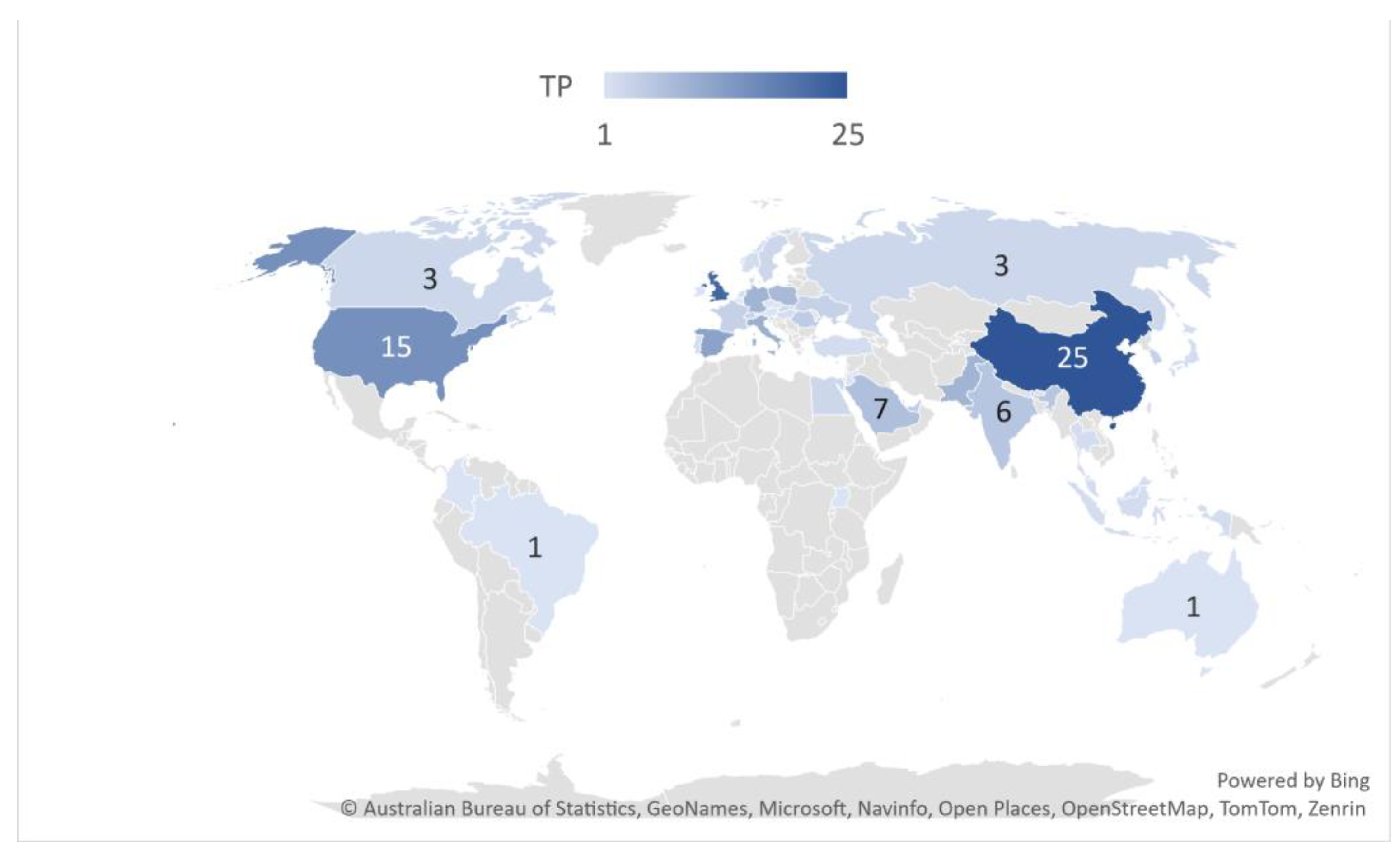
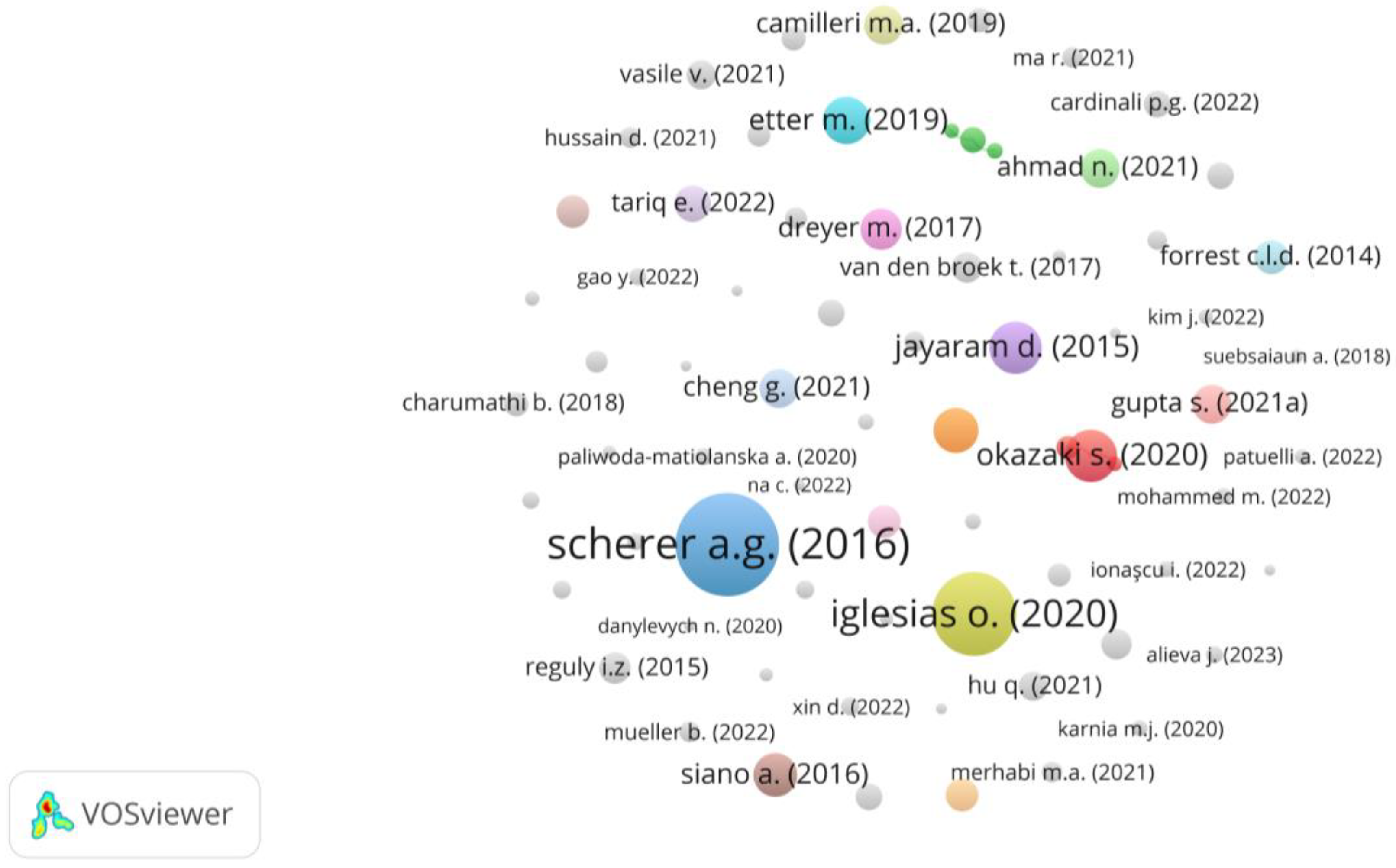
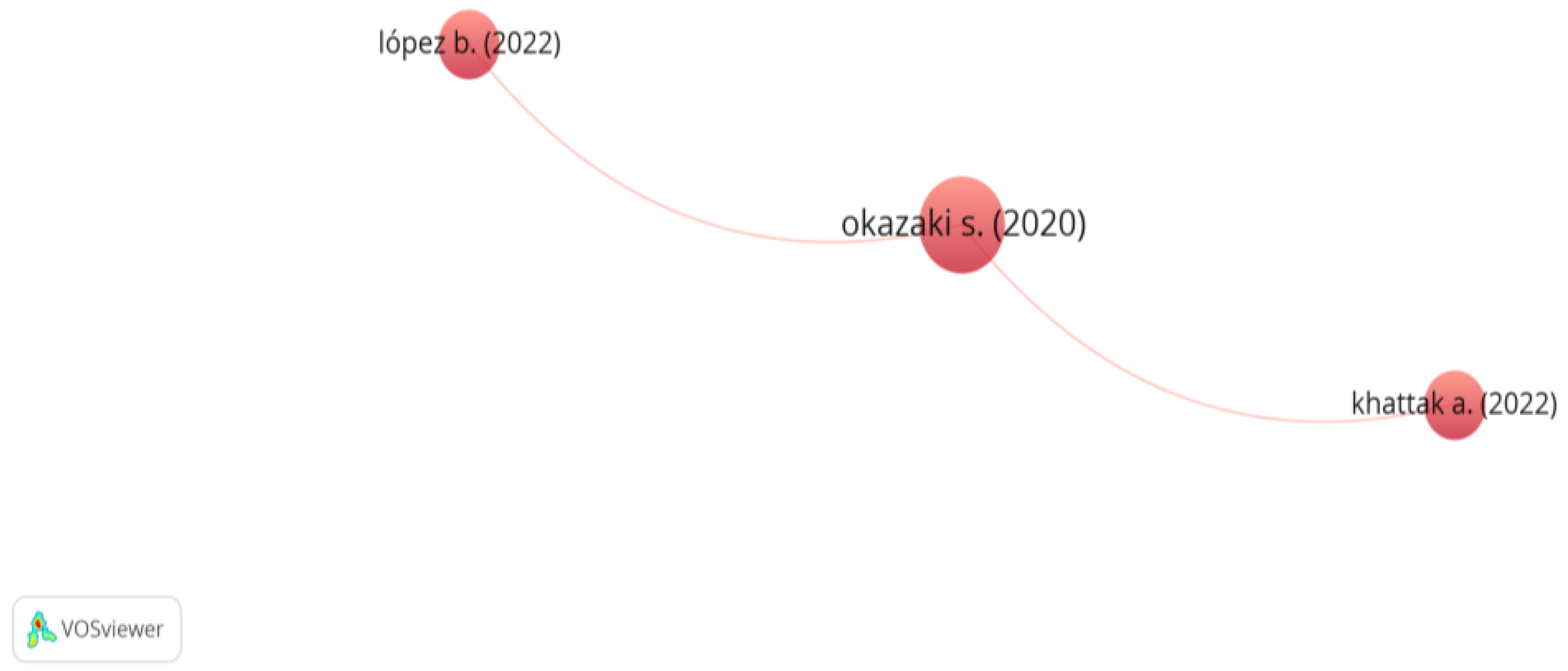
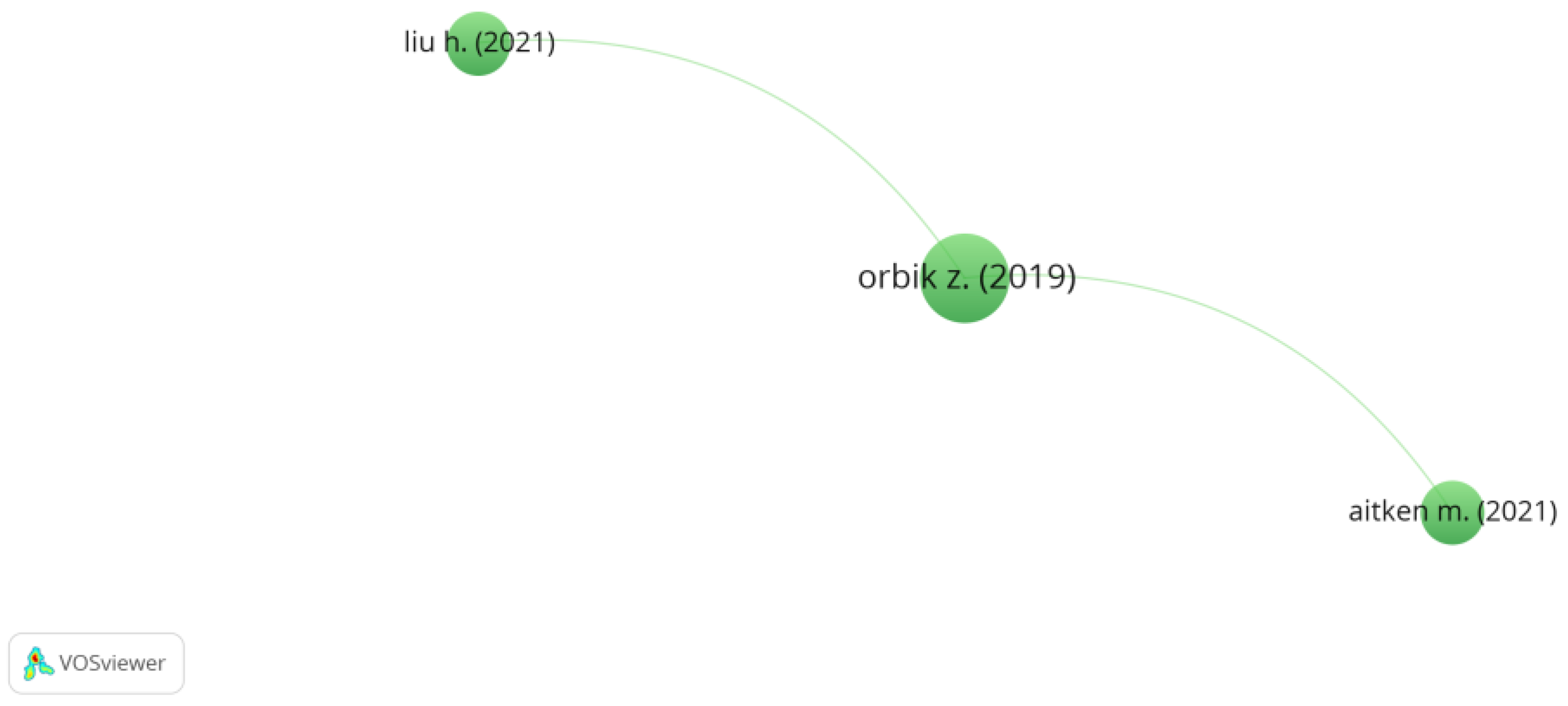
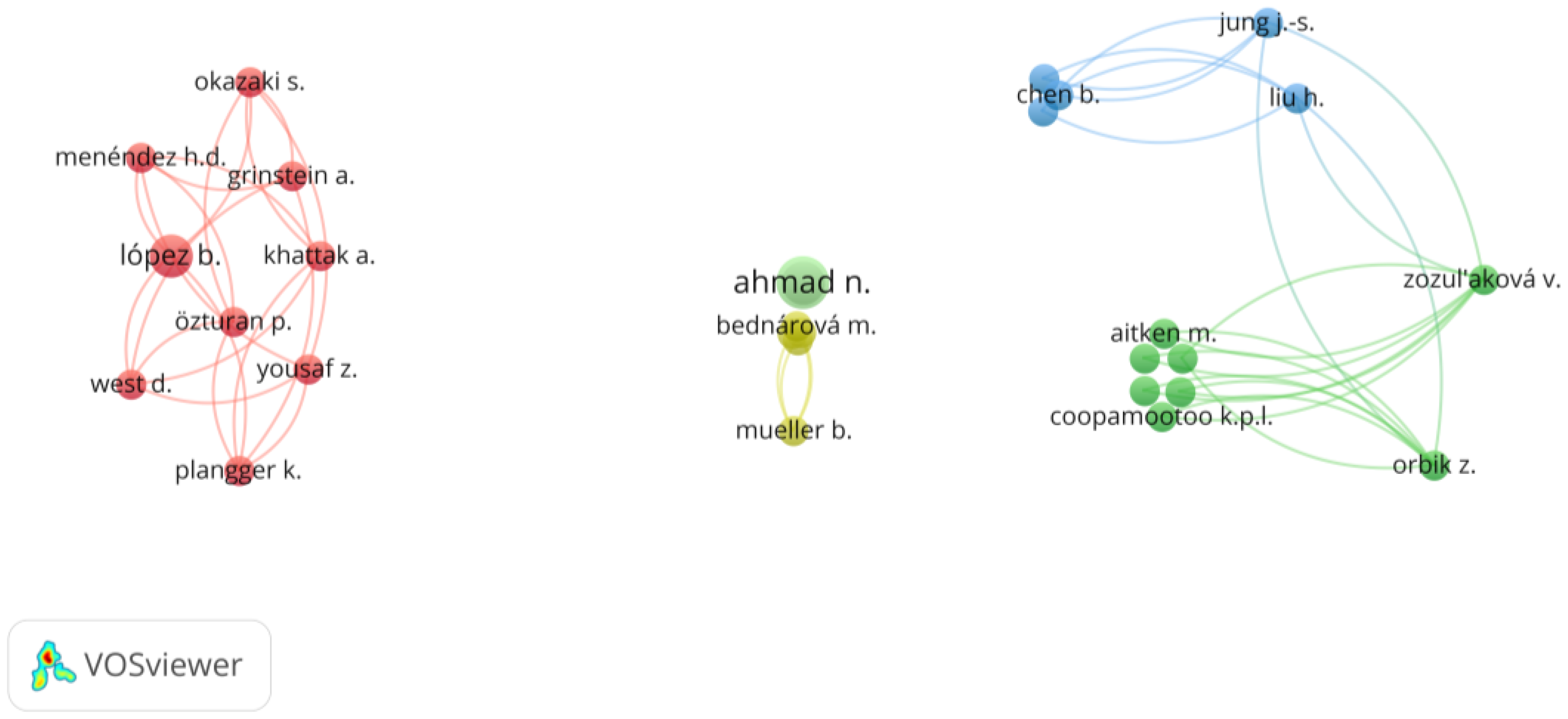
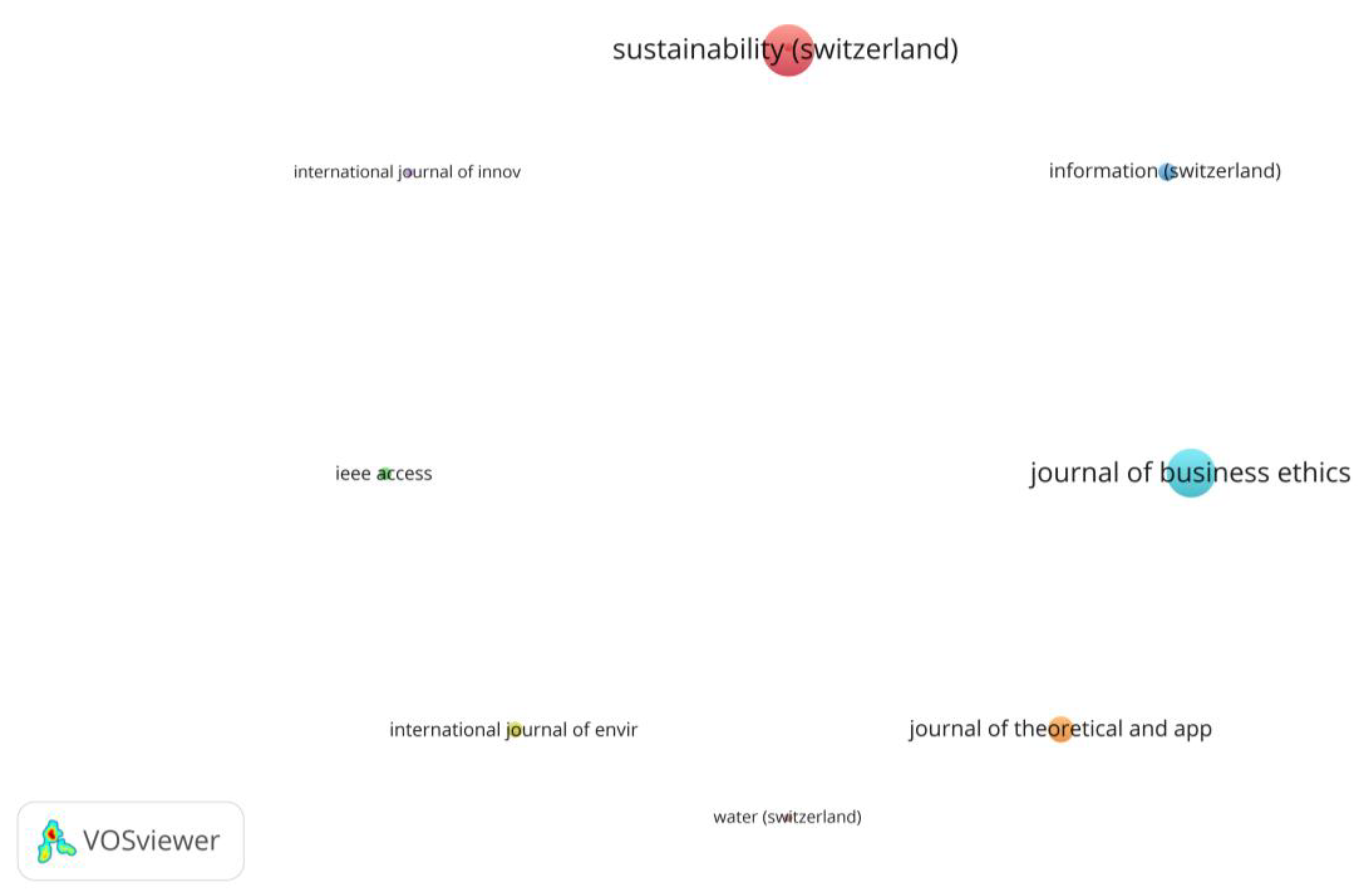
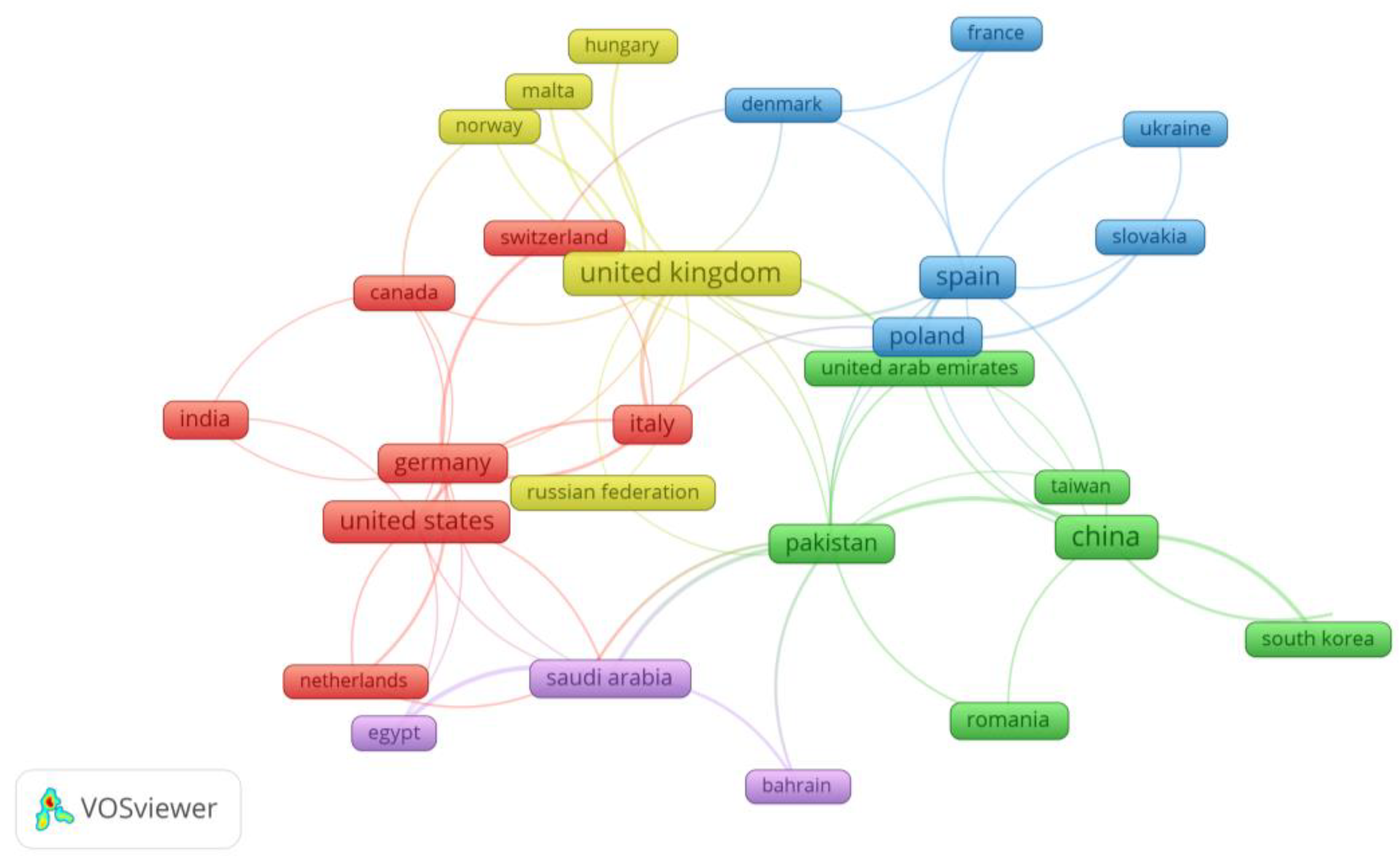
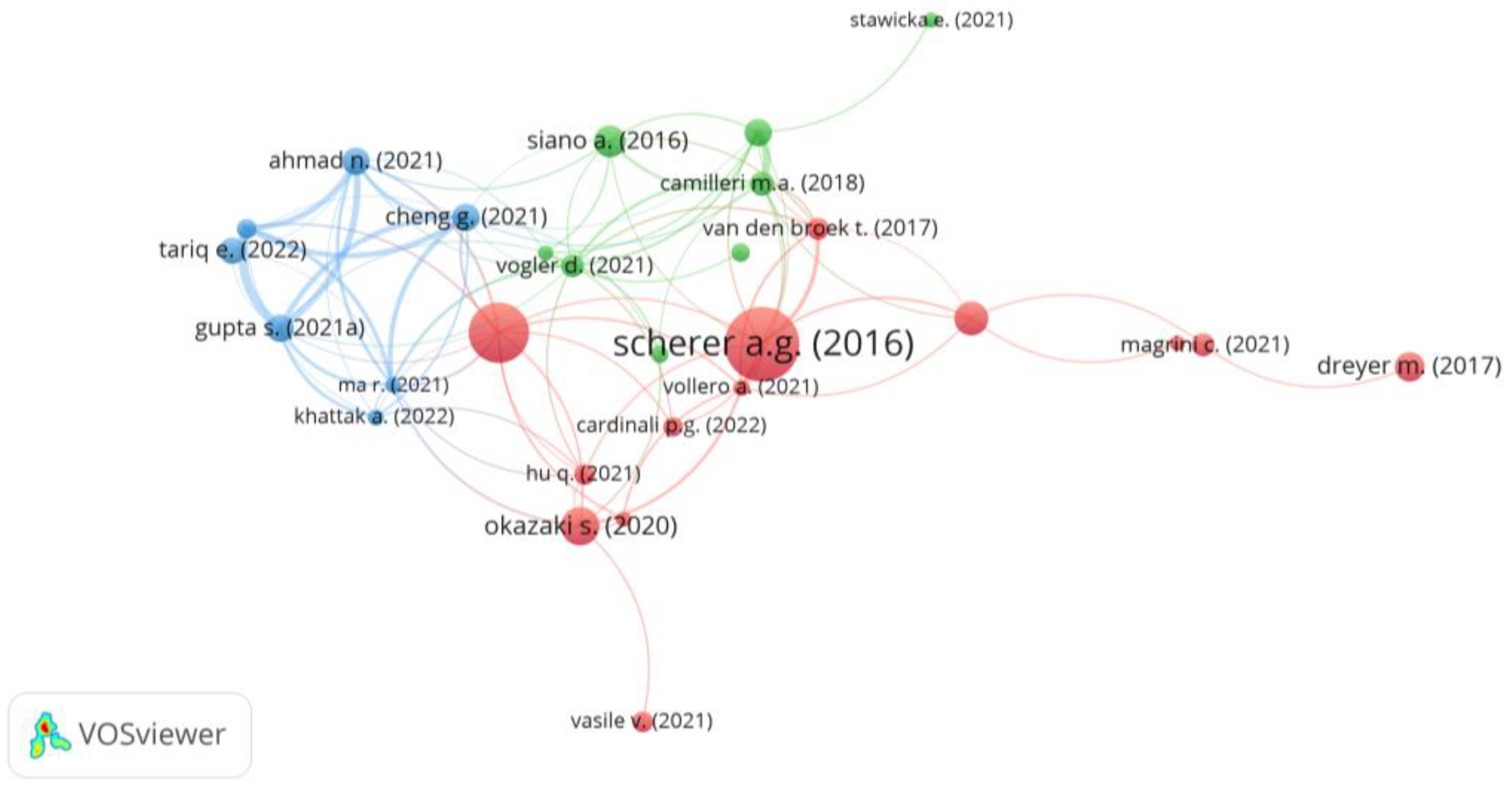
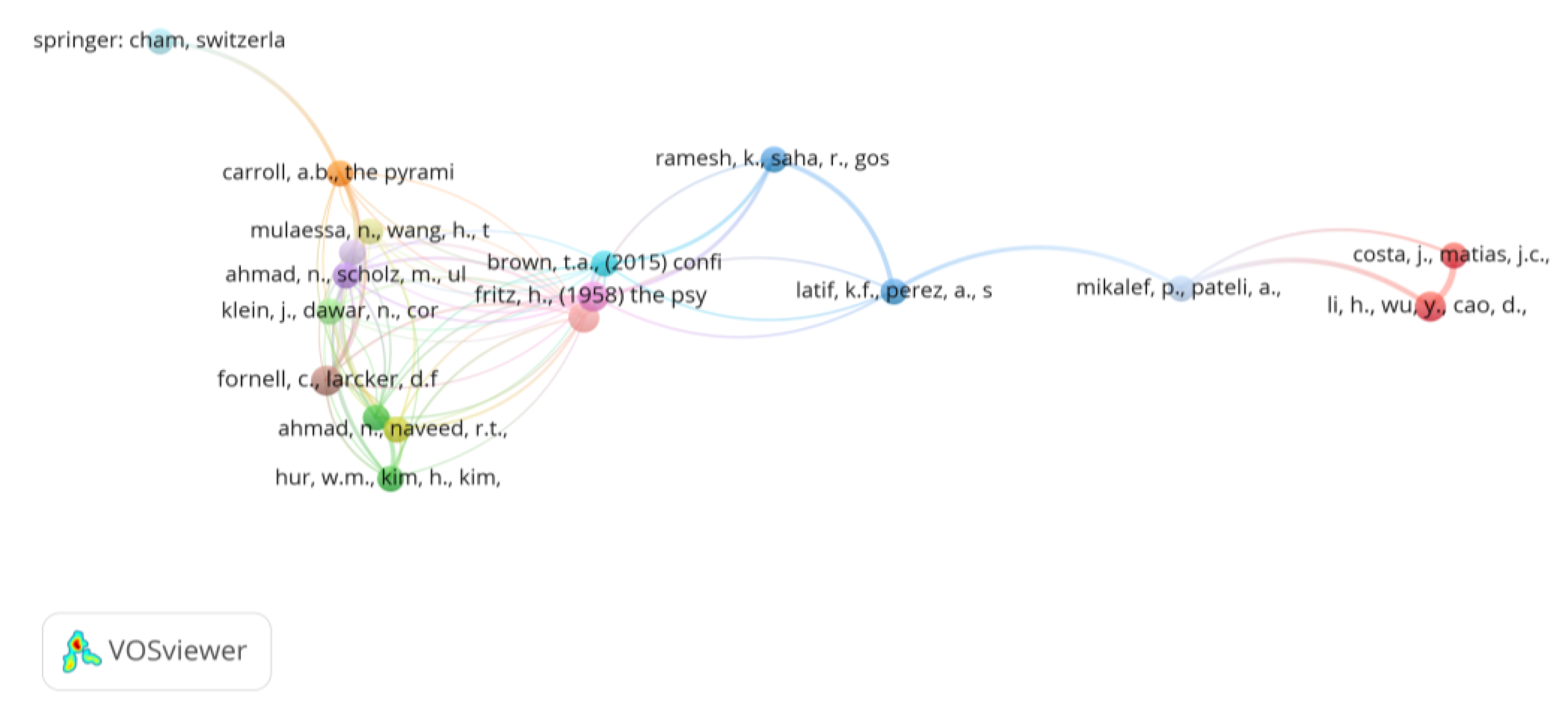
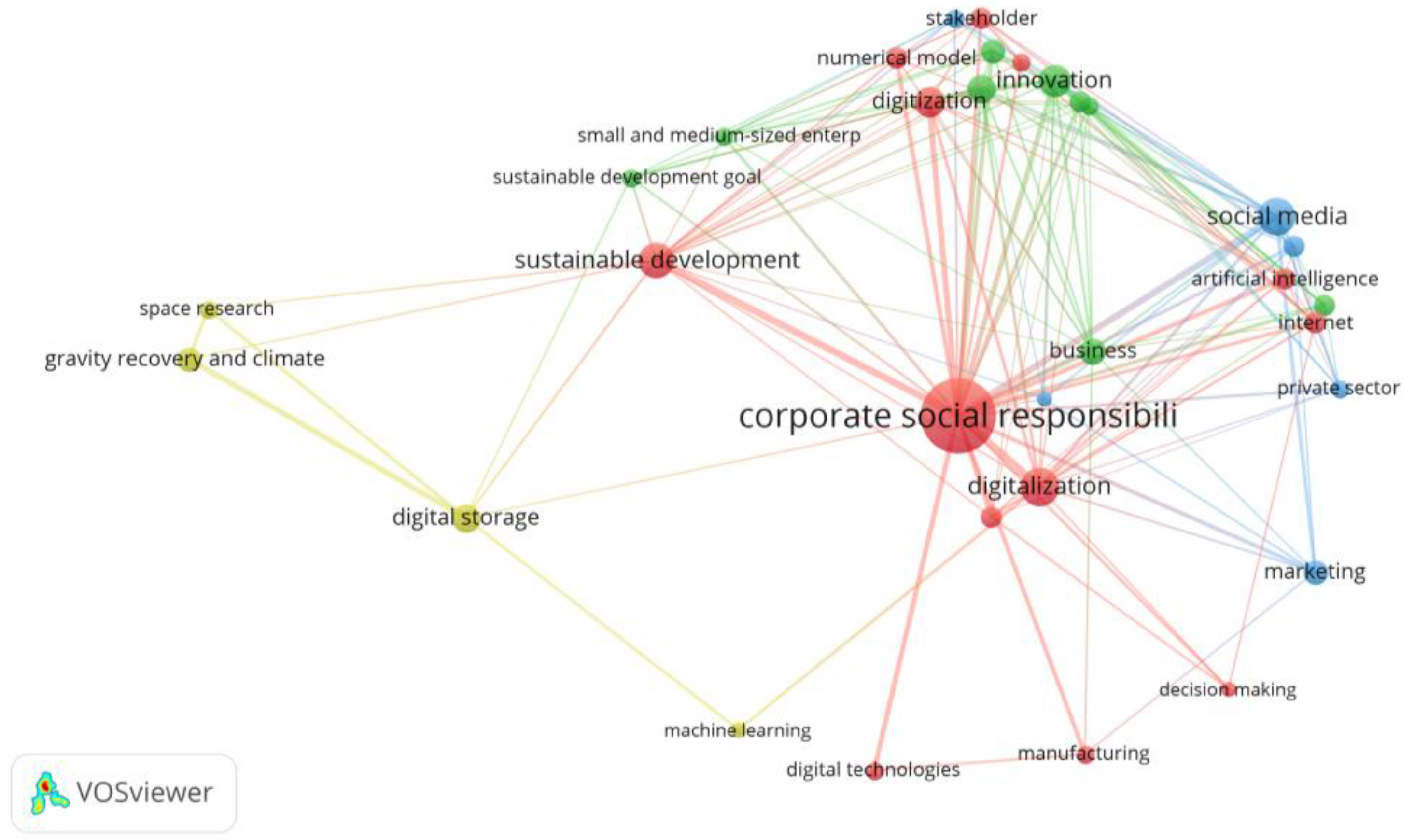
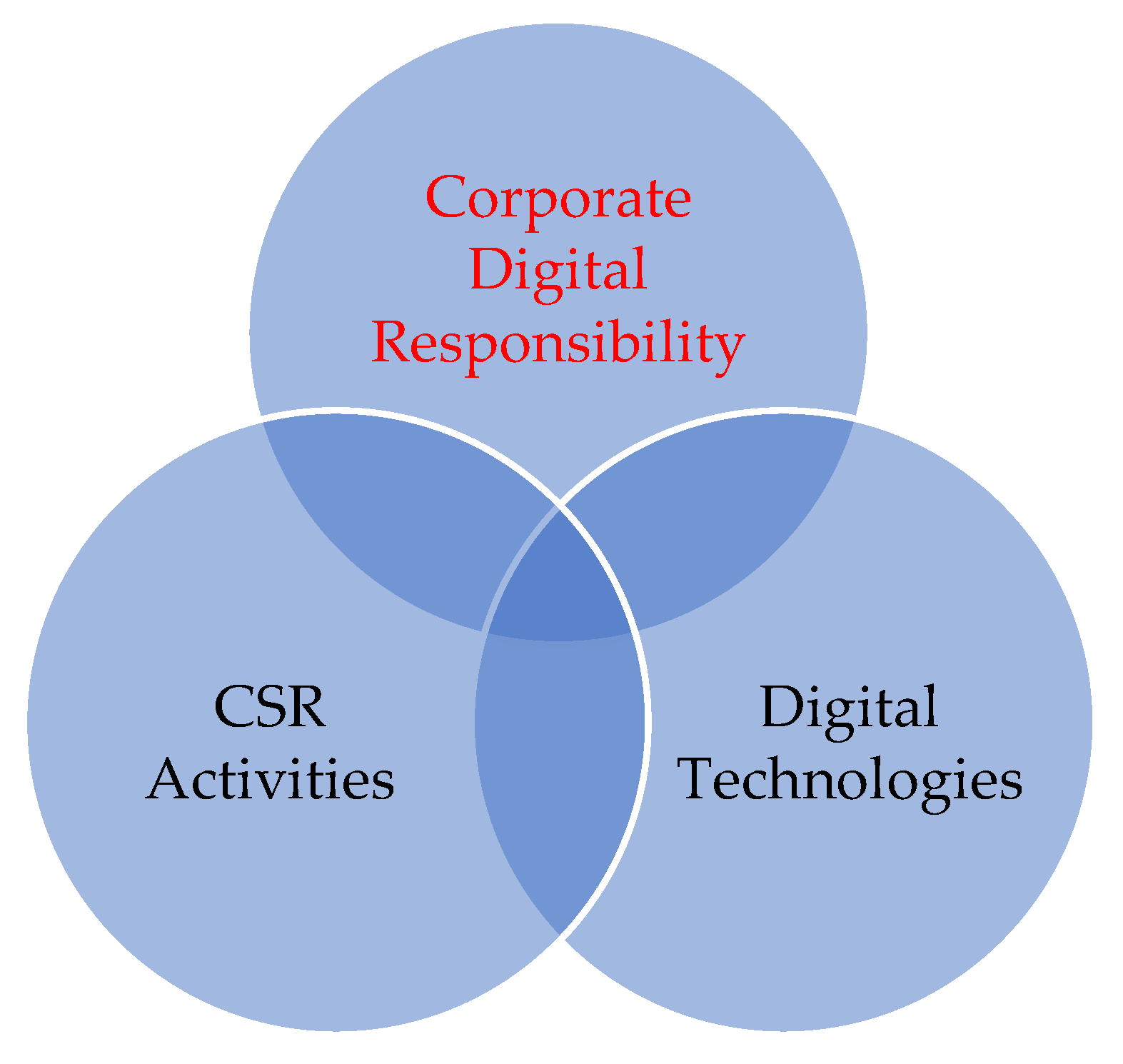
| Technique | Goal | Link | Node | Metadata |
|---|---|---|---|---|
| Citation analysis | To identify the most influential authors, publications, and sources in the research field | Relationships among publications | Documents | Author name Citations Title Journals References |
| Co-authorship analysis | To identify the most influential authors, institutions, or countries in the research field | Relationships among authors and their affiliations | Authors Affiliations | Author Affiliation (institution and country) |
| Bibliographic coupling | To understand the themes and the scope in a research field | Relationships among citing publications | Documents | Author name Title Journals DOI References |
| Co-citation analysis | To understand the development of the foundational themes in a research field | Relationships among cited publications | Documents | References |
| Co-word analysis | To explore the existing or future topics in a research field | Relationships among topics | Words | Title Abstract Author key words Index key words Full text |
| Years | Articles per Year | Articles per Author | ||||||||
|---|---|---|---|---|---|---|---|---|---|---|
| j = 1 | j = 2 | j = 3 | j = 4 | j = 5 | j = 6 | j = 7 | j = 8 | j = 9 = k | ||
| 2014 | 1 | 0 | 0 | 0 | 0 | 0 | 0 | 0 | 1 | 0 |
| 2015 | 2 | 0 | 1 | 1 | 0 | 0 | 0 | 0 | 0 | 0 |
| 2016 | 4 | 1 | 0 | 0 | 1 | 1 | 0 | 0 | 1 | 0 |
| 2017 | 7 | 1 | 1 | 1 | 0 | 0 | 3 | 1 | 0 | 0 |
| 2018 | 3 | 1 | 2 | 0 | 0 | 0 | 0 | 0 | 0 | 0 |
| 2019 | 10 | 1 | 3 | 1 | 1 | 2 | 1 | 1 | 0 | 0 |
| 2020 | 13 | 1 | 4 | 3 | 2 | 2 | 1 | 0 | 0 | 0 |
| 2021 | 29 | 2 | 8 | 3 | 5 | 4 | 4 | 2 | 1 | 0 |
| 2022 | 34 | 5 | 7 | 7 | 4 | 8 | 2 | 0 | 0 | 1 |
| 2023 | 26 | 2 | 4 | 5 | 6 | 5 | 3 | 1 | 0 | 0 |
| Total | N = 129 | F1 = 14 | F2 = 30 | F3 = 21 | F4 = 19 | F5 = 22 | F6 = 14 | F7 = 5 | F8 = 3 | F9 = 1 |
| Publication-related metrics | Results |
| Total publications (TPs) | 129 |
| Number of contributing authors (NCA) | 443 |
| Single-authored documents | 14 |
| Multi-authored documents | 115 |
| Number of years of publications (2014–2023) (Y) | 10 |
| Productivity per active year of publication (PAY = TP/Y) | 12.9 |
| Citation-related metrics | Results |
| Total citations of 98 documents (in Scopus) (TC) | 1995 |
| Average citations per document (AC = TC/TP) | 20.36 |
| Citation-and-publication-related metrics | Results |
| Collaboration index (CI) | 3.73 |
| Collaboration coefficient (CC) | 0.62 |
| Number of cited publications (NCP) | 98 |
| Proportion of cited publications (PCP = NCP/TP) | 0.76 |
| Rank | Country/Region | Total Citations | Total Cited Documents |
|---|---|---|---|
| 1 | United Kingdom | 675 | 22 |
| 2 | United States | 573 | 16 |
| 3 | France | 483 | 4 |
| 4 | China | 466 | 25 |
| 5 | Denmark | 397 | 2 |
| 6 | Switzerland | 311 | 4 |
| 7 | Spain | 221 | 12 |
| 8 | Italy | 186 | 10 |
| 9 | Pakistan | 152 | 9 |
| 10 | Germany | 108 | 9 |
| Documents | Citation in Scopus | Citation in the Sample | VOSviewer Cluster |
|---|---|---|---|
| (Scherer et al. 2016) | 241 | 0 | No |
| (Iglesias et al. 2020) | 156 | 0 | No |
| (Okazaki et al. 2020) | 63 | 2 | Red |
| (Jayaram et al. 2015) | 63 | 0 | No |
| (Etter et al. 2019) | 52 | 0 | No |
| (Jernigan and Ross 2020) | 46 | 0 | No |
| (Siano et al. 2016) | 44 | 0 | No |
| (Dreyer et al. 2017) | 39 | 0 | No |
| (Gupta et al. 2021) | 34 | 0 | No |
| (Ahmad et al. 2021b) | 34 | 0 | No |
| (Cheng et al. 2021) | 34 | 0 | No |
| (Camilleri 2019) | 34 | 0 | No |
| (Orbik and Zozul’aková 2019) | 15 | 2 | Green |
| (Khattak and Yousaf 2022) | 13 | 1 | Red |
| (Liu and Jung 2021) | 6 | 1 | Green |
| (López 2022) | 5 | 1 | Red |
| (Aitken et al. 2021) | 5 | 1 | Green |
| Total | 884 | 8 | NaN |
| Source | Published Articles | Citations in Scopus | Citations in the Sample | VOSviewer Cluster |
|---|---|---|---|---|
| Sustainability (Switzerland) | 25 | 262 | 1 | Red |
| Journal of Business Ethics | 4 | 232 | 0 | No |
| Journal of Theoretical and Applied Electronic Commerce Research | 2 | 68 | 0 | No |
| Information (Switzerland) | 2 | 32 | 0 | No |
| International Journal of Environmental Research and Public Health | 6 | 26 | 0 | No |
| IEEE Access | 2 | 16 | 0 | No |
| Frontiers in Environmental Science | 2 | 3 | 1 | Red |
| International Journal of Innovative Technology and Exploring Engineering | 2 | 3 | 0 | No |
| Water (Switzerland) | 2 | 2 | 0 | No |
| Total | 47 | 644 | 2 | NaN |
| Country | Published Articles | Citations in Scopus | Citations in the Sample | VOSviewer Cluster |
|---|---|---|---|---|
| United Kingdom | 19 | 617 | 10 | Yellow |
| Pakistan | 9 | 152 | 9 | Green |
| Spain | 12 | 221 | 6 | Blue |
| Saudi Arabia | 7 | 88 | 6 | Purple |
| Germany | 9 | 108 | 6 | Red |
| Total | 56 | 1186 | 37 | NaN |
Disclaimer/Publisher’s Note: The statements, opinions and data contained in all publications are solely those of the individual author(s) and contributor(s) and not of MDPI and/or the editor(s). MDPI and/or the editor(s) disclaim responsibility for any injury to people or property resulting from any ideas, methods, instructions or products referred to in the content. |
© 2023 by the authors. Licensee MDPI, Basel, Switzerland. This article is an open access article distributed under the terms and conditions of the Creative Commons Attribution (CC BY) license (https://creativecommons.org/licenses/by/4.0/).
Share and Cite
Atanasov, A.; Chipriyanova, G.; Krasteva-Hristova, R. Integration of Digital Technologies in Corporate Social Responsibility (CSR) Activities: A Systematic Literature Review and Bibliometric Analysis. J. Risk Financial Manag. 2023, 16, 373. https://doi.org/10.3390/jrfm16080373
Atanasov A, Chipriyanova G, Krasteva-Hristova R. Integration of Digital Technologies in Corporate Social Responsibility (CSR) Activities: A Systematic Literature Review and Bibliometric Analysis. Journal of Risk and Financial Management. 2023; 16(8):373. https://doi.org/10.3390/jrfm16080373
Chicago/Turabian StyleAtanasov, Atanas, Galina Chipriyanova, and Radosveta Krasteva-Hristova. 2023. "Integration of Digital Technologies in Corporate Social Responsibility (CSR) Activities: A Systematic Literature Review and Bibliometric Analysis" Journal of Risk and Financial Management 16, no. 8: 373. https://doi.org/10.3390/jrfm16080373
APA StyleAtanasov, A., Chipriyanova, G., & Krasteva-Hristova, R. (2023). Integration of Digital Technologies in Corporate Social Responsibility (CSR) Activities: A Systematic Literature Review and Bibliometric Analysis. Journal of Risk and Financial Management, 16(8), 373. https://doi.org/10.3390/jrfm16080373







